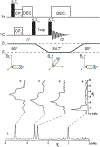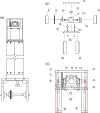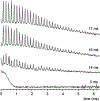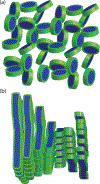Spatial reorientation experiments for NMR of solids and partially oriented liquids
- PMID: 26592947
- PMCID: PMC6936739
- DOI: 10.1016/j.pnmrs.2015.10.001
Spatial reorientation experiments for NMR of solids and partially oriented liquids
Abstract
Motional reorientation experiments are extensions of Magic Angle Spinning (MAS) where the rotor axis is changed in order to average out, reintroduce, or scale anisotropic interactions (e.g. dipolar couplings, quadrupolar interactions or chemical shift anisotropies). This review focuses on Variable Angle Spinning (VAS), Switched Angle Spinning (SAS), and Dynamic Angle Spinning (DAS), all of which involve spinning at two or more different angles sequentially, either in successive experiments or during a multidimensional experiment. In all of these experiments, anisotropic terms in the Hamiltonian are scaled by changing the orientation of the spinning sample relative to the static magnetic field. These experiments vary in experimental complexity and instrumentation requirements. In VAS, many one-dimensional spectra are collected as a function of spinning angle. In SAS, dipolar couplings and/or chemical shift anisotropies are reintroduced by switching the sample between two different angles, often 0° or 90° and the magic angle, yielding a two-dimensional isotropic-anisotropic correlation spectrum. Dynamic Angle Spinning (DAS) is a related experiment that is used to simultaneously average out the first- and second-order quadrupolar interactions, which cannot be accomplished by spinning at any unique rotor angle in physical space. Although motional reorientation experiments generally require specialized instrumentation and data analysis schemes, some are accessible with only minor modification of standard MAS probes. In this review, the mechanics of each type of experiment are described, with representative examples. Current and historical probe and coil designs are discussed from the standpoint of how each one accomplishes the particular objectives of the experiment(s) it was designed to perform. Finally, applications to inorganic materials and liquid crystals, which present very different experimental challenges, are discussed. The review concludes with perspectives on how motional reorientation experiments can be applied to current problems in chemistry, molecular biology, and materials science, given the many advances in high-field NMR magnets, fast spinning, and sample preparation realized in recent years.
Keywords: Dynamic angle spinning; Instrumentation; Liquid crystals; Switched angle spinning; Variable angle spinning.
Copyright © 2015 Elsevier B.V. All rights reserved.
Figures

















References
-
- Grandinetti PJ, Baltisberger JH, Llor A, Lee YK, Werner U, Eastman MA, Pines A, Pure-absorption-mode lineshapes and sensitivities in 2-dimensional dynamic angle spinning NMR, Journal of Magnetic Resonance Series A 103 (1) (1993) 72–81.
-
- Gann SL, Baltisberger JH, Pines A, Dynamic-angle spinning without sidebands, Chemical Physics Letters 210 (4–6) (1993) 405–410.
-
- Klinowski J, Spin-off for solid-state studies, Nature 346 (1990) 509–510.
-
- Grandinetti P, The Encyclopedia of NMR, Wiley, 1996, Ch. Dynamic Angle Spinnng, pp. 1768–1776.
-
- Zax DB, dynamic angle spinning and double rotation quadrupolar NMR, Trends in Analytical Chemistry 13 (8) (1994) 300–312.
Publication types
MeSH terms
Substances
Grants and funding
LinkOut - more resources
Full Text Sources
Other Literature Sources

